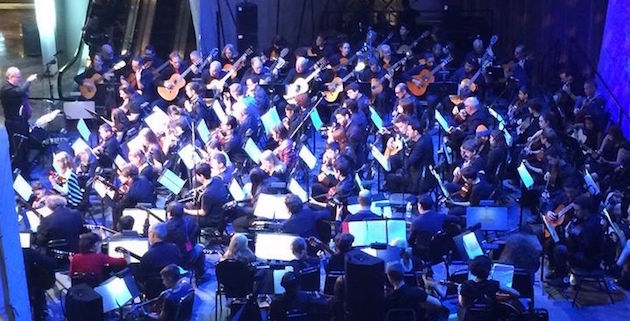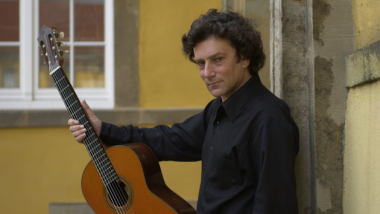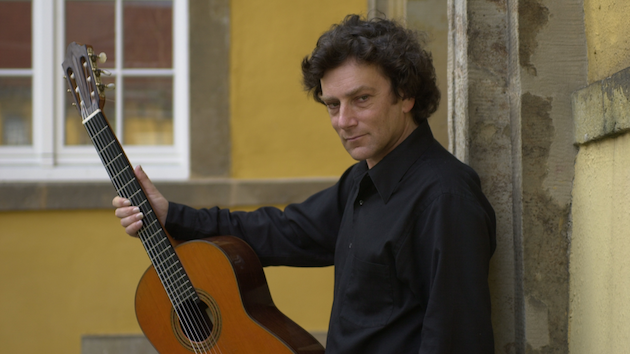
We stopped by the San Francisco Conservatory of Music the other day to catch a word with David Tanenbaum. His office is on the fifth floor — past students huddled against the walls, lost in the bedlam of their devices — down a narrow, carpeted hall with lockers on one side and, on the other, classroom doors with small windows; altogether the feel of modern and efficient, if also like a newly renovated county jail.
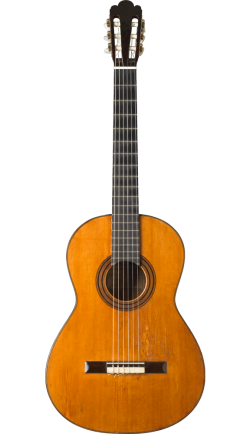
David Tanenbaum, just turning 60, is one of the most prominent guitarists of his generation, and in 1988 became the first American guitarist to play in China at the invitation of the government. He’s also an educator with irrepressible enthusiasm and an encyclopedic knowledge of all things guitar. He chairs the Conservatory’s guitar department, which this fall has 32 students, five faculty members, and 43 guitars, as well as a distinguished collection of instruments, including one made by the legendary Spanish guitarist and luthier, Antonio de Torres Jurado (1817–1892).
In David’s office, about the size of a 9-by-12 Persian Rug, there’s a poster of the “father of the guitar,” Francisco Tárrega (1852 – 1909), posing with a Torres guitar, in fact one made after the one on exhibit at the Conservatory. Below the poster, more than two-dozen guitars, in their cases. David knows each instrument intimately and, as though recounting never forgotten lovers, can tell you the particular delights of each.
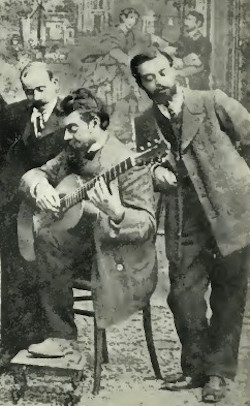
His attraction always reminds him of a friend, a woman who fell in love with a man so obsessed with his guitar that he seemed barely able to look up at her — much less at other women, she thought, and so decided to marry him. That was 40 years ago.
This is also a bit of Tanenbaum, the intoxicant, ever captivated by alder, ash, and rosewood, along with being able to touch nylon strings with both hands, entranced from the start by the instrument’s classical music properties, but also by its other magics; the way, for example, George Harrison came to write, “While My Guitar Gently Weeps.”
Tanenbaum is a man with bushy hair, a wry smile, jovial and intense, always watching you from under the rims of his glasses, and, naturally, dressed in black — that performance color noted by John Harvey in his book Men in Black, a 19th-century fashion color to convey gentility but also the Dickensian notion that all life is essentially funereal.
Tanenbaum is very well-known in the guitar world, and is particularly respected for his advocacy of new music and new guitar repertory. He was the commissioner behind several major guitar compositions by modernist luminaries like Hans Werner Henze, Toru Takemitsu, and minimalist master Terry Riley. And he has recorded the complete guitar music of Sofia Gubaidulina.
In the course of a long conversation that took in music, education, and much else, we also touched on an unusual concert coming up on Sunday, September 18 at 2 p.m. at the conservatory’s Caroline H. Hume concert hall. The offering, which is free, is the West Coast premiere of David Lang’s 2015 piece, Questionaire. David Lang is best known recently for the gorgeous score he wrote for the 2015 Paolo Sorrentino film, Youth.
Takeaways Regarding a Musical Education
Here are some take aways from our conversation about the nature of a classical music education these days.
The level of technical expertise has never been greater, and interest in learning to play has never been greater — despite a generation of musicians that hopes to make a living playing the instrument but at the same time, often expects free access to concerts, recordings, and sheet music.
Conservatory students, like students everywhere, are smarter than ever, yet in David’s experience, and this is a national trend, attention spans are in decline, which means that, occasionally, presentations must be dumbed down.
Paul Simon’s new album, Stranger to Stranger, includes three and four-minute songs interspersed with one-minute interludes, so that listeners, as David points out, “don’t have to concentrate so much.”
The inability to research and digest large amounts of information, and then recast it in one’s own words — enabled by the cut-and-paste ease of the Internet — has made plagiarism more of an issue than it used to be.
Writing skills, including structure, syntax, and imagination, are less developed than they were 10 years ago. This, despite the fact that many students will end up teaching in academia. There’s also the constant need for performers to write program notes, an obvious but critical element in career building.
Segovia’s Message
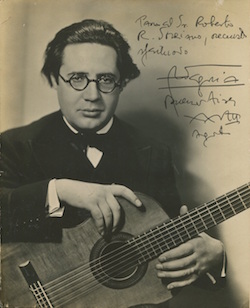
David Tanenbaum grew up the son of a composer at the Manhattan School of Music, his father; and his mother, a full-time piano teacher who also “kept the dinner warm” in New Rochelle. Literally. David insists he was not a prodigy but he remembers singing Mozart on park swings at three, reading music at four, studying piano for eight years, cello for four years, and practicing obsessively. But then one day at age 11, he “hit the wall.” Sounding like a disillusioned man in middle age he told his parents he was through with music and needed a year off. His piano teacher agreed. His parents shook their heads.
Not long afterwards, his father took him to a concert, in an “old dead movie theater,” with an extremely wide stage, and there in the middle was Andrés Segovia. His music filled the hall as well as a child’s imagination.
“I kind of knew my future at that ridiculously early moment; I also realized that I had to combine the classical things I’d been doing with piano and cello with this new instrument. And so I’m thinking to myself, I know how a Bach prelude is played on the keyboard but I’ve got to figure out how he does it on the guitar. What I didn’t realize was that Segovia had to arrange it from C-Minor to D-Minor.”
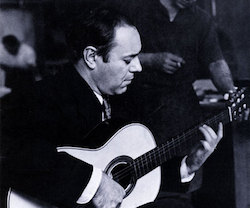
Young master Tanenbaum decided he needed a new teacher and eventually found one, down in Greenwich Village: a Cuban virtuoso named Rolando Valdés-Blain. Every Saturday the kid would show up at 1 p.m. at the apartment of Mr. Blain who was always just waking. He would gather up a fat Cuban cigar and a bottle of wine, and give the kid a boot-camp lesson that lasted for five straight hours. Blain would later arrange an audition with the Joffrey Ballet, and Tanenbaum quickly found himself traveling and, playing with some the nation’s great orchestras.
“I think of my son,” said Tanenbaum. “He’s 24 and he’s facing such a different world than I did. It’s so difficult to navigate a career these days. I’ve always been very lucky in a way because from the beginning, I’ve never had to face that moment when you wonder, ‘where do I go next?’”
He pointed to another career problem as well. Tanenbaum is part of a cohort of guitar department heads who are all within about 10 years of each other in age and just now are clogging the career arteries for younger talent.
“We just took the field over and we even created jobs that didn’t exist before, and so now this younger generation is blocked out but I keep telling my son that within the next few years there are going to be a lot of retirements.”
On “Guitar Culture”
The new technological “norm” for guitars is amplification. Traditional venues, including the halls at SFJazz and Freight & Salvage Coffeehouse in Berkeley, for example, don’t work for the acoustic guitar. “Composers I’ve worked with,” says David, “including Hans Werner Henze and Lou Harrison regard the mic as ‘an extra sound source’; they hate it. On the other hand, the Los Angeles Guitar Quartet, which is four guitars, told me that when they started amplifying their concerts they could almost see people sit back in their chairs and relax.”
In the debate over whether to play with nylon or steel strings (Segovia played on gut), nylon with its softer sound, has been the norm for certain kinds of folk and traditional music, and is a popular choice with beginning players. But in recent years steel has become popular because it projects so much better. Moreover, new technology has now stopped strings from squeaking. An occasional high-pitched squeak was once accepted as part of the ambiance of the medium, but no longer.
Segovia (1893 – 1987) once famously remarked, “My kingdom for a repertoire.” He himself, created a new repertoire but didn’t work with the great composers of his day, Stravinsky and Ravel, for example. The great, English, classical guitarist Julian Bream changed that, but these days there is no dominant guitarist to match him.
Nevertheless, there is a steady stream of guitar concertos and more instances of the guitar being used as part of the orchestra. Consider works by Henze, Toru Takemitsu, Peter Maxwell Davies, and Aaron J. Kernis. At the same time, there is a conservative streak in the guitar world, beginning with Segovia, where people are often not open to new works.
Young composers face ever-greater challenges in a postmodern world with no common musical language, no stylistic norms, little structure, and crumbling borders between genres. Sonatas are out; “Ironic Music” is in. Note Michael Daugherty’s 1996 piece for flute and classical guitar: I love Lucy. Or “classical composer” Jacob Ter Veldhuis’ 1999 piece for tenor sax or e-guitar and boom box, grab it! (composed for an episode of the TV documentary series, Scared Straight.)
Grab it! is a 10-minute piece based on “voice samples” from prisoners serving life sentences as well those on death row. Ter Veldhuis, a multimedia composer known as “Jacob TV,” imagined the work as “a kind of duet, a ‘duel’ if you like. The horn competes in unison with a perpetual range of syllables, words, and sentences, which demands intense endurance from the performer. The meaning of the lyrics becomes gradually clear during the piece, as well as the hopeless situation for the prisoners.”
In the piece, the “MF” word is used some 30 times. While the overall effect is “sad,” Jacob TV has been quoted to say, “There is also a sense of ‘memento vivera’. Life is worth living: Grab it!”
To Risk or Not to Risk
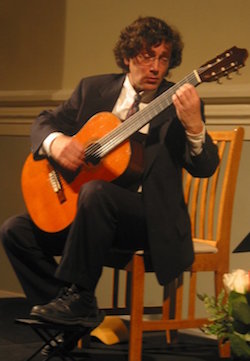
While students continue to study the guitar and composers continue to write music for the guitar, Tanenbaum believes that the instrument’s fate seems equally tied to the fact that generally people are buying less music and going to fewer concerts. Moreover, the solo guitar concert has become nearly an anachronism.
“Think of it from the point of view of the audience,” said David. “Here you are without your remote control, looking at just one person for an entire evening. It’s hard! And from a musician’s point of view, if you get that chance to be onstage and perform, how much are you going to risk at that point? It’s very daunting for young people.
“And then add the fact that we live in a culture in which ‘the customer is always right’, people are afraid of offending the customer.”
Not to mention an impatient music culture oriented to the thumbs up, thumbs down style of American Idol, where there’s no chance for an audience to become accustomed to and see the virtue of something unusual.
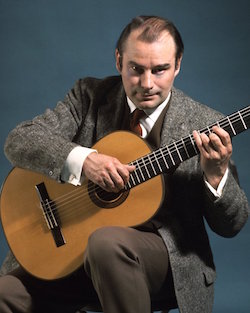
Tanenbaum remembers watching Julian Bream, playing a new Henze piece in New York City several years ago. “It’s a piece I worship and I’ve recorded it twice. It’s long; just the first part is 30 minutes. And I remember that after that first 30 minutes a third of the crowd walked out. The two-thirds of us who stayed will never forget that concert. And why did so many people leave? Because it was in-your-face, atonal music. People said to themselves, ‘I’m not going to listen to this’ and walked right out.”
Yet Bream’s reaction was to come back the very next year with a similar piece, by Peter Maxwell Davies.
“It’s hard to think of a young guitarist who would do that now, unless they were painted into the corner of new music. The danger for the musician is that if you do that too much, you just become a ‘new music guitarist’ and you lose a lot of the general public and some of the guitar public, but you get another crowd.”
117 Guitars
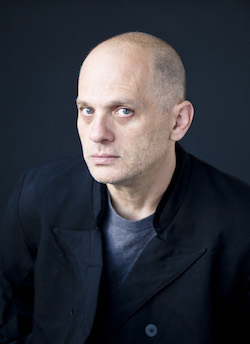
The David Lang piece being performed on September 18, Questionnaire, is a 20-minute composition for 120 guitars. It was commissioned by the Third Street Music Settlement and premiered in October 2015. It is a ridiculously ambitious idea on the one hand — just the challenge of tuning instruments boggles the mind — but also because, as Tanenbaum notes, “We won’t know what we have until the moment when we do it.”
When we spoke to him, Tanenbaum had assembled 117 guitars, coming from, among other places, the Conservatory, San Francisco State, City College, the Oakland School of the Arts, and the San Francisco School of the Arts. Abilities range from beginner to expert.
The work is based on the format of an actual questionnaire. And so a narrator, in this case the conservatory’s president, David Stull, will ask questions from the podium and the musicians will respond musically. Questions range from what’s your name and where do you live, to would you rather be ice or steam; would you rather live on the sun or the moon; what’s the worst thing you’ve ever touched.
There are no specific political questions. Musicians write their answers on a work sheet and then find a way to play them. The idea is that you play it back at the same rate as you might say it. The rhythm of the answer will change with each question. Pacing will be decided by Stull who must judge when a question has been answered. The expectation is of a wall of sound with various colors determined by synchronicities among the players themselves.
“I would say the piece is about identity, about personhood,” said Tanenbaum. “What would be a bad performance? I asked David (Lang) that and he replied that it would be one that’s not serious, a performance that becomes sarcastic or ironic.
“You know there’s so much irony and sarcasm in the world today and for something like this it would so easy for a guitarist to say, ‘oh, this is ridiculous. It doesn’t matter what my answer are.’ But David’s notion is that you’ll be able to tell if the musicians are telling the truth or not. Because it will be a different sound and you as the audience will be able to hear it.”
